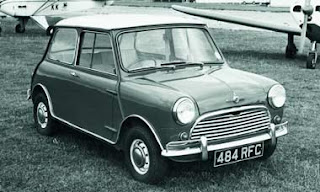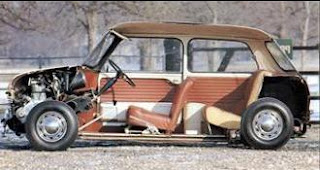Sliding windows allowed storage pockets in the hollow doors; reportedly Issigonis sized them fit a bottle of Gordon's Gin. The boot lid was designed with the hinges at the bottom so that the car could be driven with it open to increase luggage space. On early cars the number plate was hinged so it swung down to remain visible when the boot lid was open. This design was later discontinued as it was discovered that exhaust gases could leak into the cockpit while the boot was open.

The Mini was designed as a monocoque shell with welded seams that are visible on the outside of the car running down the A and C pillars, and between the body and the floor pan showing where the joins are. To further simplify construction, the car had external door and boot hinges. All of these novel and elegant technical innovations resulted in a car with minimum overall dimensions yet maximized space for both passengers and luggage.

Production models differed from the prototype by the addition of front and rear sub frames to the unibody to take the suspension loads, and by turning the engine around with the carburettor at the back rather than at the front. This required an extra gear to be placed between engine and transmission to reverse the engine direction. Making this a reduction gear had the beneficial effect of reducing loads on the gearbox and preventing the rapid wear on the synchromesh which had been a problem on early prototypes. Having the carburettor at the rear helped to reduce carburettor icing, but did expose the distributor to water coming in through the grille.
The engine size was reduced from 948 cc to 848 cc, which reduced the top speed from an unprecedented 90 mph (145 km/h) to a more manageable (for the time) 72 mph (116 km/h), as well as reducing cabin noise quite a bit. This decision was reversed in 1967.
Despite its utilitarian origins, the classic Mini car shape had become so iconic that by the 1990s, Rover Group — the heirs to BMC — were able to register its design as a trade mark in its own right.





